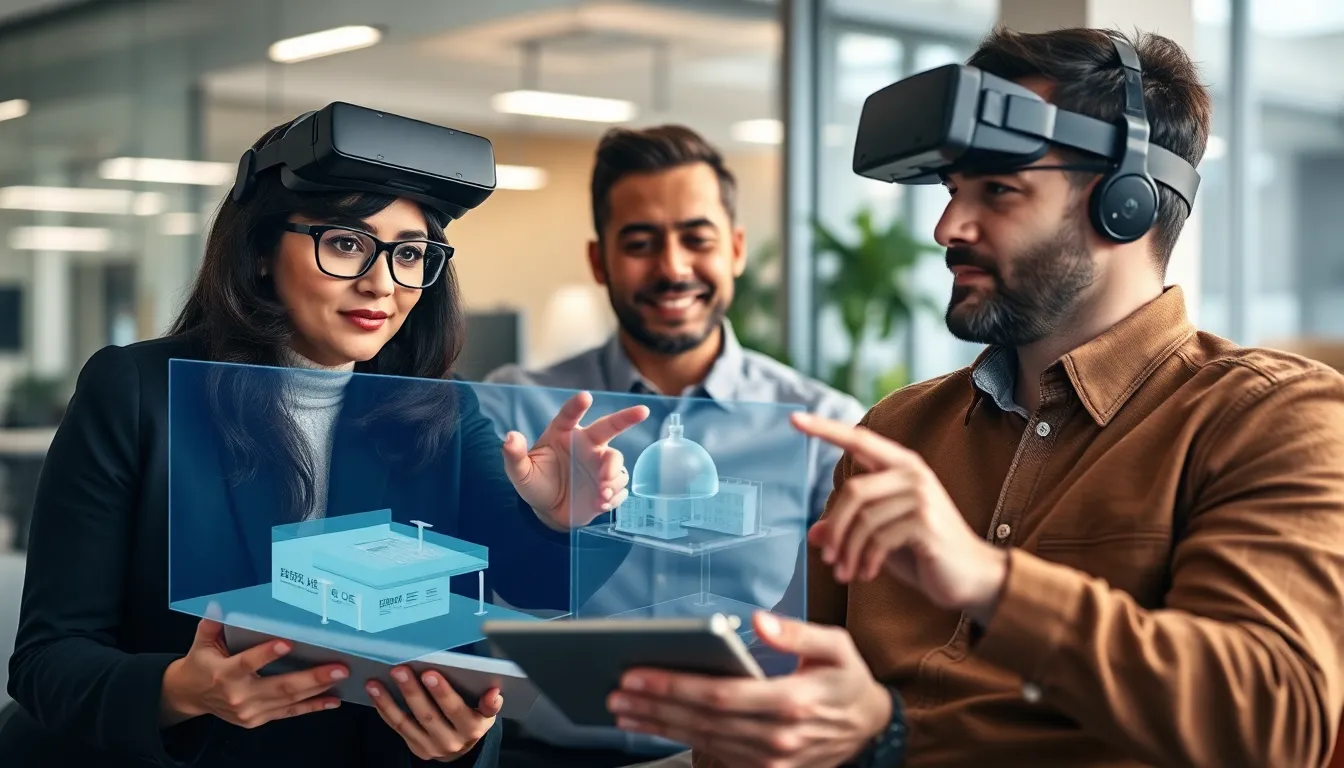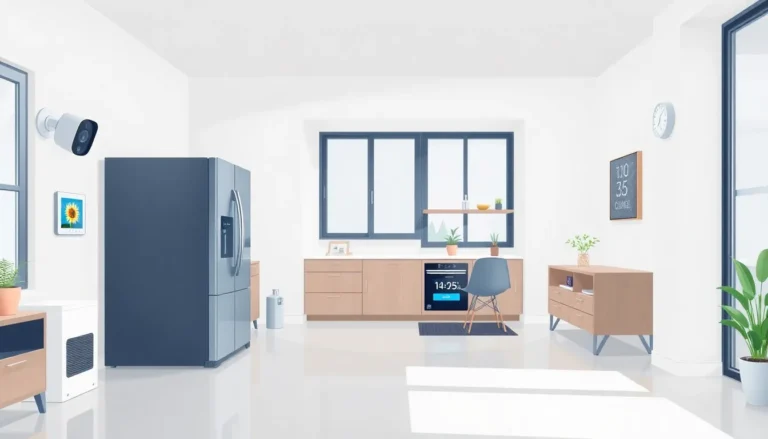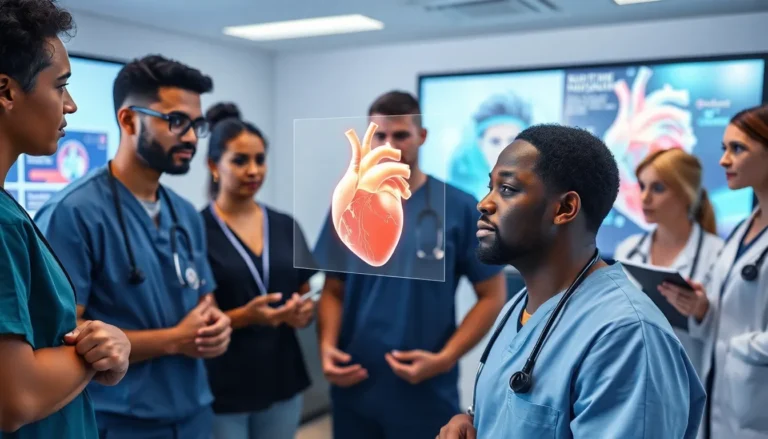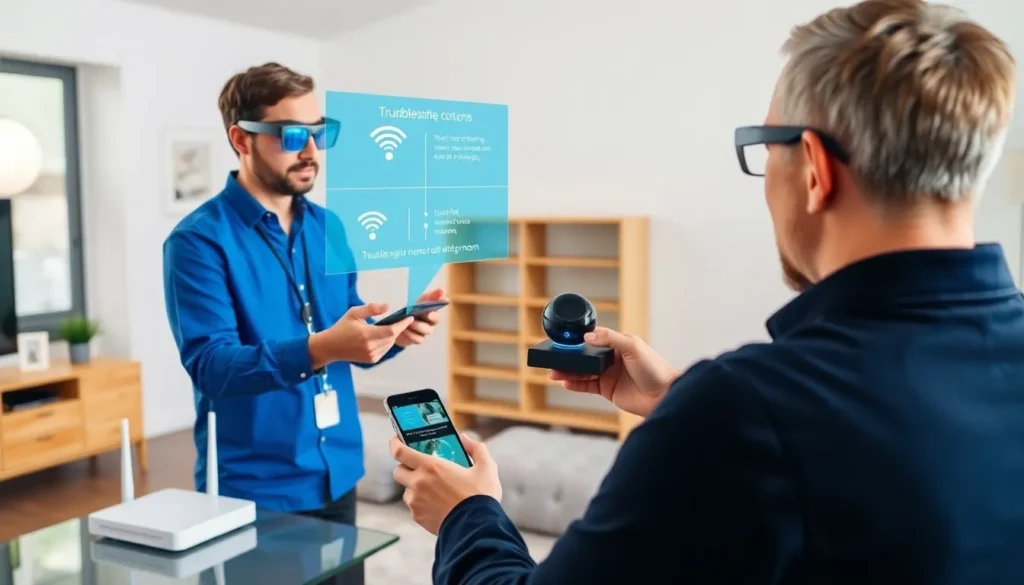Table of Contents
ToggleImagine a world where fixing your Wi-Fi isn’t a battle of wills with a tech support agent over the phone. Enter augmented reality remote assistance, the superhero of troubleshooting. With just a smartphone or smart glasses, experts can guide users through complex repairs as if they were right there in the room. No more deciphering cryptic instructions or hoping for a miracle; it’s like having a tech wizard on speed dial.
Overview of Augmented Reality Remote Assistance
Augmented reality (AR) remote assistance revolutionizes how technical support is delivered. This technology involves overlaying digital information in real-time onto a user’s environment, allowing experts to visualize problems without being physically present. By utilizing smartphones or smart glasses, technicians can see exactly what users see, offering step-by-step guidance.
Users encounter real-time support through interactive visual cues. They receive invaluable assistance in navigating complex procedures. AR remote assistance simplifies troubleshooting processes, which can reduce resolution times considerably. Instead of relying on difficult manuals, users receive immediate feedback and support tailored to their specific issues.
Numerous industries benefit from this innovative technology. For example, healthcare personnel can assist remote patients with device malfunctions while manufacturers improve efficiency in assembly line operations. The application extends to training scenarios, ensuring employees acquire necessary skills with hands-on guidance.
Data emphasizes significant improvements. Companies utilizing AR remote assistance experience faster resolution times, often decreasing technical support calls by up to 40%. Productivity gains also signal a positive shift, with users reporting higher satisfaction levels due to intuitive interactions.
Multiple platforms now offer AR remote assistance solutions. These include well-known names in technology, ensuring accessibility across various devices. As the technology evolves, its integration into daily operations becomes more seamless, further enhancing user experiences.
AR remote assistance transforms traditional support avenues into interactive, engaging interactions. It drives efficiency, promotes user independence, and paves the way for future innovations in remote troubleshooting.
Benefits of Augmented Reality Remote Assistance

AR remote assistance presents significant advantages for users and organizations. Enhanced collaboration and improved efficiency stand out as key benefits.
Enhanced Collaboration
AR remote assistance fosters stronger teamwork among users and experts. Real-time communication tools support interactive problem-solving, bridging geographical gaps. Users can share their environment with technicians through video feeds, enabling specialists to guide them step-by-step. This approach leads to quicker resolutions, as instant feedback allows for necessary adjustments during the process. With visual aids like arrows and highlights overlayed onto their surroundings, users feel more confident in executing tasks. Various industries now experience this enriched collaboration, creating a more engaging support experience.
Improved Efficiency
AR remote assistance dramatically improves operational efficiency. Organizations that adopt this technology report reductions in technical support call times by up to 40%. Experts can address multiple issues simultaneously, enhancing resource management. By digitizing instructions, reliance on extensive manuals decreases, streamlining the resolution process. Increased access to real-time support reduces downtime for users, helping them return to productivity faster. Consequently, organizations benefit from higher overall satisfaction rates, as users appreciate the intuitive nature of this assistance. Ultimately, AR remote assistance transforms traditional support behaviors into more efficient interactions.
Applications of Augmented Reality Remote Assistance
Augmented reality remote assistance finds broad applications across various sectors, enhancing operational efficiency and user experience.
Healthcare
In healthcare, AR remote assistance plays a crucial role in patient care. Medical professionals use this technology for remote consultations, enabling specialists to guide on-site staff through complex procedures. A surgeon can view a 3D overlay of the patient’s anatomy during an operation, providing real-time guidance. This method improves training, allowing trainees to observe expert techniques live. Research shows that AR assistance reduces procedural errors and increases patient safety. By enhancing telemedicine capabilities, healthcare providers increase access to expertise, benefiting both urban and rural patients.
Manufacturing
Manufacturing benefits significantly from AR remote assistance through streamlined maintenance and training. Technicians receive step-by-step instructions overlaid on machinery, allowing for faster repairs and reduced downtime. Companies report a decrease in technical support calls by up to 40%. This technology aids in onboarding new employees, offering interactive tutorials and real-time guidance. Moreover, teams enhance collaboration by sharing visual perspectives, fostering teamwork. The implementation of AR tools results in improved operational efficiency, allowing experts to manage multiple issues at once without extensive manuals.
Education
Educational institutions leverage AR remote assistance to create immersive learning experiences. Instructors can guide students through complex concepts with real-time visualizations. This interactive method fosters engagement and understanding, making challenging subjects more accessible. Data indicates that students retain information better through AR, supporting varied learning styles. Moreover, remote support enhances the training of professionals across disciplines, from engineering to healthcare. By incorporating AR into their curricula, schools prepare students for future careers in technology-driven environments. Efforts in integrating this technology showcase its potential in revolutionizing education.
Challenges of Implementing Augmented Reality Remote Assistance
Implementing augmented reality remote assistance presents several challenges that organizations must address for successful adoption.
Technical Limitations
Technical limitations often hinder the effective use of augmented reality remote assistance. Connectivity issues can disrupt real-time interactions, causing delays in troubleshooting. Additionally, device compatibility may vary across platforms. Many users lack advanced technology, limiting access to required hardware such as smartphones or smart glasses. Processing power also impacts performance; insufficient hardware may result in lagging visual aids, reducing user effectiveness during guidance. To overcome these limitations, organizations need to invest in robust infrastructure and ensure that users possess compatible devices to maximize AR benefits.
User Adoption
User adoption presents a significant challenge in implementing augmented reality remote assistance. Many individuals express reluctance to embrace new technologies, especially if they lack familiarity with AR tools. Training programs become crucial for ensuring users understand how to utilize augmented reality effectively. Resistance can lead to underutilization of technology, which undermines potential benefits like faster resolution times. Companies often witness a learning curve; however, once users gain confidence, they tend to appreciate the streamlined support AR offers. Encouraging ongoing feedback helps organizations enhance user experience and encourages wider adoption of augmented reality solutions.
Future Trends in Augmented Reality Remote Assistance
Emerging trends in augmented reality (AR) remote assistance indicate significant advancements. Cloud computing integration enhances data accessibility, allowing technicians to store and retrieve information seamlessly. Artificial intelligence (AI) tools, when combined with AR, offer predictive analytics that further streamline troubleshooting processes.
5G technology adoption accelerates the effectiveness of AR remote assistance. Improved connectivity supports real-time video feeds, resulting in higher-quality interactions. User experiences benefit from this enhanced speed, leading to more effective support sessions.
Cross-industry collaboration emerges as a key trend. Companies can share knowledge and best practices, fostering innovation in AR applications. This collaborative effort boosts efficiency, promoting shared solutions to common issues.
Data privacy and security will drive future developments. Organizations prioritize robust security measures as AR usage increases. Protection against potential cyber threats becomes crucial for maintaining user trust and ensuring safe interactions.
User training focuses on overcoming the challenges of technology adoption. Familiarization with AR tools leads to improved proficiency and confidence. Effective training programs contribute to overall user satisfaction, evidenced by a rise in productivity.
Industry-specific applications for AR remote assistance continue to grow. In healthcare, remote surgeries utilize AR for expert guidance, enhancing patient safety. Manufacturing sectors increasingly rely on AR for training, which reduces downtime and speeds up production.
Adaptive interfaces promise to improve usability for diverse audiences. Personalized experiences cater to varying skill levels among users. Enhancements in technology create more intuitive interactions, further promoting widespread adoption.
Each of these trends contributes to the evolving landscape of AR remote assistance. Organizations leveraging these advancements will likely witness reduced resolution times, greater user satisfaction, and enhanced operational efficiency.
Augmented reality remote assistance is reshaping how industries tackle challenges by providing real-time guidance and support. Its ability to overlay digital information onto the physical world enhances user interactions and streamlines problem-solving processes. As organizations continue to adopt this innovative technology, the benefits become increasingly evident in areas like efficiency and collaboration.
With advancements in connectivity and integration with AI, AR remote assistance is poised for even greater impact. The ongoing evolution of this technology promises to further enhance user experiences and operational performance across various sectors. Embracing AR remote assistance not only addresses current challenges but also prepares organizations for a future driven by innovation and efficiency.







